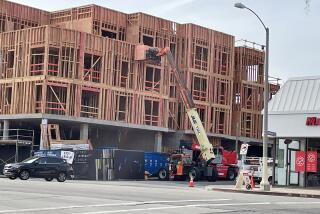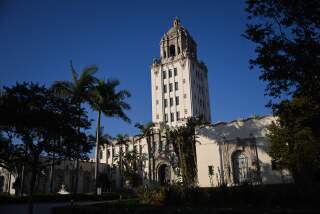Viewpoints : Dangers of a Development Slowdown : Real estate: Long approval processes and escalating fees are making projects so costly that Greater Los Angeles’ economic vitality may be stunted.
- Share via
The City of Los Angeles recently approved construction of Watt City Center, a 1.6-million-square-foot office complex located downtown, west of the Harbor Freeway. As part of the deal, the developers agreed to include an on-site day-care center, implement a state-of-the-art traffic management system and pay $38 million in fees and taxes. That added about $24 a square foot to the cost of construction.
Nonetheless, some citizens groups wanted the city to impose even greater taxes and fees.
Watt City Center’s costly approval process is not unique. Throughout Southern California, government officials and citizens have begun to take the real estate development industry for granted--so much so that the local development industry is nearing a crisis point.
If that happens, the losers will be our metropolitan region’s economy and most Angelenos. Let me explain why.
In recent years, Los Angeles’ real estate development industry has revived downtown Los Angeles, created over a dozen “urban cores” throughout the metropolitan area and built homes for a population that is increasing at the rate of 250,000 a year. The real estate industry, moreover, is one of Greater Los Angeles’ largest employers.
One problem afflicting Greater Los Angeles’ development industry is the ever-lengthening time required to process projects through the municipal bureaucracy. Five or six years ago, it typically took up to 18 months to get a proposed commercial project through city Planning, Building and Safety, Transportation, and other departments. Now, it can take three years--or more--to reach groundbreaking.
What’s the reason for this slowdown? A shortage of funding? A lack of trained personnel?
Whatever the reason, this processing slowdown is discouraging much-needed development in Los Angeles, and it has also boosted the cost of projects passing through these bureaucratic roadblocks. As a result, office and industrial park rents are higher, putting Los Angeles at a competitive disadvantage with nearby markets.
A second problem for the development industry is “zoning by whim.” Responsible elected officials and neighborhood groups that favor “managed growth” have encouraged high-quality real estate development throughout Southern California in recent years. But many worthwhile projects have not been approved because they have become unwilling hostages to less responsible “no-growth” citizens’ groups that are more concerned with their self-serving NIMBY (“not in my back yard”) agendas than with enhancing the city’s economy and the lives of its residents.
A third problem is the burdensome fees that real estate developers must pay to gain approval for their projects, such as Watt City Center. To some Angelenos, real estate developers have become the blank checks for governmental services that taxpayers funded in pre-Proposition 13 days. Is it really the total responsibility of developers to pay for subsidized housing? Street improvements? Public art?
In Los Angeles today, processing delays, fees and annoying red tape typically account for one-third of the cost of a new commercial building. How many developers can afford to pay such exorbitant costs? When will Los Angeles developers start looking for more agreeable locales?
Our real estate developers deserve better, and not just because they are major employers in Southern California. Without continuous and responsible real estate development, Los Angeles will not fulfill its civic destiny or provide adequate opportunities for its residents.
If developers cannot erect enough office buildings or industrial parks to satisfy market demands, for instance, the rate of job creation will fall and fail to keep pace with our soaring population. As the amount of available space declines, moreover, office and industrial rents will inevitably rise. Cost-sensitive businesses and industries will limit their growth in Greater Los Angeles or leave the region altogether, as happened to once-smug Manhattan and San Francisco when their rents spiraled upward in recent years.
The cost of housing, to cite another example, will rise even higher due to anti-growth ordinances and unreasonable development fees. Because Greater Los Angeles is growing at the rate of 250,000 people a year, the development industry must create the equivalent of almost three Santa Monicas every year!
How can developers comfortably and affordably create homes for these new Angelenos if in-town neighborhoods fight apartment buildings and outlying areas oppose almost all new construction? Once again, the laws of supply and demand, plus the exaction of development fees, will boost the cost of housing to unnecessarily high levels.
Finally, transportation will become even more snarled if Greater Los Angeles continues to hinder real estate development. Let’s bury the myth once and for all that development is solely responsible for our snarled streets and freeways.
Aside from inadequate funding for road construction and upkeep, one reason for our traffic problem is the imbalance between jobs and housing within Greater Los Angeles. If no-growth NIMBY homeowners’ groups prevent the construction of office projects in Encino and Woodland Hills, for example, residents of Calabasas will simply be forced to drive farther to the West Side or downtown to find good jobs.
Another reason for snarled traffic is the high cost of housing in reasonably convenient neighborhoods, forcing more and more Angelenos to purchase homes at the more affordable fringe of the metropolitan area.
If our real estate developers continue to be taken for granted, Los Angeles could lose its economic momentum and falter, much like many East Coast and Midwest cities did in the 1950s and 1960s.
If you think that this decline can’t happen to Los Angeles, take a look at San Francisco, which has lost some of its major employers in recent years, or economically stagnant Denver, which once stymied growth but now eagerly seeks its benefits.
Like it or not, Los Angeles is already suffering the ill effects of its let’s-take-real-estate-for-granted attitude. Downtown development is slowing, because, in part, of the unnecessary delays in project approvals. Los Angeles needs the income from these developments to pay for its hard-pressed social welfare programs, public safety programs and mass transit.
Individual companies are already “voting with their feet,” and taking their jobs out of town. Carnation, for instance, left Wilshire Boulevard and built its new headquarters on Brand Boulevard in Glendale due, in part, to the difficulty of the development process in Los Angeles. Another major corporation with its national headquarters in Los Angeles is seriously thinking about leaving the city for the same reason.
Given Greater Los Angeles’ many advantages, the declines that now afflict once-proud San Francisco and Denver need not happen here if we take some obvious but controversial actions.
First, our municipal bureaucracies must speed up the processing time for proposed real estate projects. Time is money in real estate development, and the increased development costs simply are passed on to the eventual home buyer or office tenant, thereby making Southern California a less desirable place in which to live or work.
Second, government must avoid “zoning by whim” and instead adopt--and follow--regional growth plans that serve the needs of all Southern Californians, not just a few no-growth NIMBY-motivated pressure groups. For instance, “managed-growth” zoning should encourage higher-density development near mass transit lines, thereby creating a built-in ridership for the system, and it should favor mixed-use projects, because these usually offer the benefit of substantial traffic reduction.
Third, government must lessen burdensome development fees. Of course, a project should pay for its reasonable impact on the nearby streets and infrastructure. But projects should not be expected to pay for normal government responsibilities such as low-income housing or open space. These additional costs are only passed on to eventual purchasers and tenants. The solution to burdensome development fees is revising Proposition 13 and raising taxes so that government can better perform its traditional services for the benefit of all Southern Californians.
More to Read
Inside the business of entertainment
The Wide Shot brings you news, analysis and insights on everything from streaming wars to production — and what it all means for the future.
You may occasionally receive promotional content from the Los Angeles Times.










